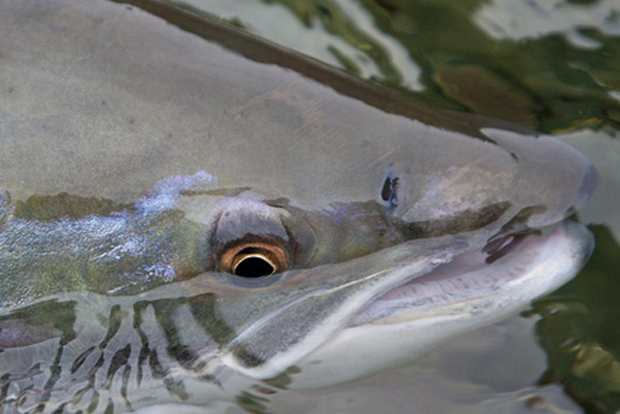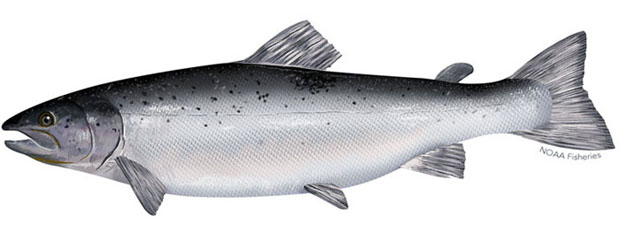Where do Pacific salmon go in the ocean?
Contrary to earlier beliefs, many salmon from North American rivers roam far at sea in the North Pacific Ocean and the Bering Sea. Atlantic salmon migrate, principally, to Greenland.
The oceanic distribution of the salmon is dependent upon the species and point of origin. Sockeye and chinook salmon from northwest Alaska, for example, may migrate across the Bering Sea to areas close to Kamchatka, Russia, and south of the Aleutian Islands into the North Pacific Ocean; the sockeye also migrate eastward to the Gulf of Alaska. Salmon such as the pink, chum, and coho from central and southeast Alaska, British Columbia, and Washington State, migrate out into the northeastern Pacific and Gulf of Alaska. Many steelhead trout from Washington and Oregon are known to migrate far at sea to areas off the Alaskan Peninsula. Some salmon migrate several thousand miles from the time they leave the rivers as juveniles until they return as adults. A chinook salmon tagged in the central Aleutian Islands and recovered a year later in the Salmon River, Idaho, had traveled about 3,500 miles; a steelhead trout tagged south of Kiska Island (western Aleutians) was recovered about six months and 2,200 miles later in the Wynoochee River, Washington.
It is the landlocked subspecies of a sockeye salmon. The kokanee spends its entire life in fresh water and usually does not attain the size of its sea-migrating cousin
 Do landlocked Pacific salmon die after spawning?
Do landlocked Pacific salmon die after spawning?
Yes. This phase of their life history is the same as their seagoing relatives. Kokanee, or silver trout – no IGFA records. These salmon are from several parent species of salmon.
How large do salmon get?
Chinook:
Weights of 100-pounds and slightly over have been reported from European countries for the Atlantic salmon; the record for the largest of the Pacific species, chinook, is 126-pounds for a fish caught on commercial gear in Alaskan waters.
International Game Fish Association (IGFA)
Chinook Salmon IGFA
All-Tackle: (97 lb 4 oz) Kenai River, Alaska, USA 17-May-1985.
Fly Fishing: Tippet (8 lb) – (71 lb 8 oz) Rogue River, Oregon, USA 21-Oct-2002.
Chinook Salmon-coho (Oncorhynchus tshawytscha x O. kisutch) IGFA
All-Tackle: (35 lb 8 oz) Salmon River, Pulaski, New York, USA, 21-Oct-2001.
Atlantic Salmon IGFA
All-Tackle: (79 lb 2 oz) Tana River, Norway, 01-Jan-1928,
Fly Fishing: Tippet (16 lb) – (51 lb 2 oz) Alta River, Norway, 07-Jul-1994.
Atlantic Salmon – landlocked IGFA
All-Tackle: (26 lb 12 oz) Torch Lake, Michigan, USA, 22-Oct-2010.
Fly Fishing: Same as above – world record was on fly rod.
Kokanee Salmon – Oncorhynchus nerka
Chum Salmon IGFA
All-Tackle: (35 lb 0 oz) Edye Pass, British Columbia, Canada 11-Jul-1995
Fly Fishing: Tippet (16 lb) – (28 lb 8 oz) Terrace, British Columbia, Canada 11-Sep-2003.
Coho Salmon IGFA
All-Tackle: (33 lb 4 oz) Salmon River, Pulaski, New York, USA, 27-Sep-1989.
Fly Fishing: Tippet (16 lb) – (21 lb 8 oz) Eyak River, Cordova, Alaska, USA 07-Sep-1996.
Pink Salmon IGFA
All-Tackle: (14 lb 13 oz) Monroe, Washington, USA, 30-Sep-2001.
Fly Fishing: Tippet (12 lb) – (10 lb 14 oz) Kenai River, Soldotna, Alaska, USA, 26-Aug-2010.
Sockeye Salmon IGFA
All-Tackle: (15 lb 3 oz) Kenai River, Alaska, USA, 09-Aug-1987.
Fly Fishing: Tippet (16 lb) – (14 lb 8 oz) Mulchatna River, Alaska, USA,16-Jul-1993.
What is the oldest known age of salmon and steelhead?
Chinook: 7 years
Sockeye 7 years
Coho 4 years
Chum 6 years
Pink : 2 years
Atlantic salmon: 8 years
Steelhead trout: 8 years
Is a steelhead a salmon or a trout?
The steelhead is a rainbow trout that migrates to sea as a juvenile and returns to fresh water as an adult to spawn. Unlike the Pacific salmon, the steelhead trout does not always die following spawning and may spawn more than once and return to the sea after each spawning.
How old are salmon when they migrate from fresh water to the ocean?
Varies with species
Chinook: fall chinook, 3-4 months after hatch – spring chinook, 12-16 months
Coho: 12-24 months
Chum: a week to a month
Sockeye: 12 months to 36 months
Pink: a week to a month.
Sources. National Oceanic and Atmospheric Administration (NOAA), International Game Fish Association (IGFA), Alaska Dept. of Fish and Game,









Join the discussion One Comment